
If you asked most executives and senior sales leaders if they would like to radically transform business results and future-proof their sales force, their answer would be a resounding, “Yes!” Yet, many are unsure how to proceed. This article provides a path forward, but keep in mind the advice here is neither simple nor complete. Each step could easily be its own chapter in a book.
Step 1: Strategy First, Then Tactics, and Then Execution
Action-oriented leaders tend to move quickly, often without doing a completion- or quality-check of the strategic planning, go-to-market tactical planning, and talent and execution activities on this chart.
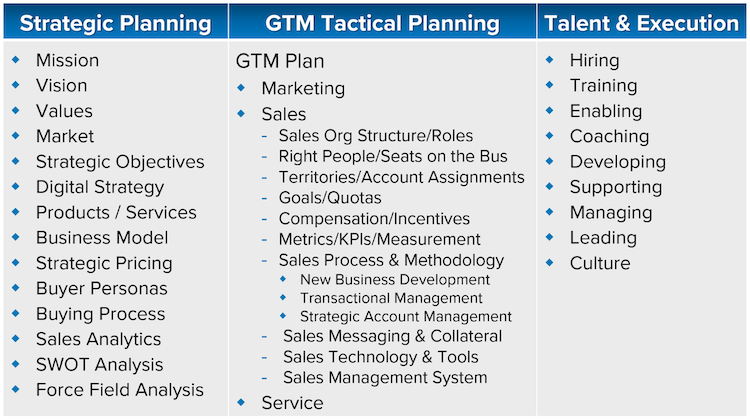
In general, you should move left to right, due to dependencies. Consider that “good enough for now” may be acceptable with a continuous improvement loop. For others, such as understanding your market/buyers, product-market fit, business model, digital strategy, and strategic objectives, you’ll want to be as accurate as possible, because so much other work builds on those.
Step 2: Acquire Buyer Acumen
Buyer acumen is a deep understanding of your buyers. It starts with well-conducted buyer persona research by having experts interview your customers and others like them. In addition to the typical persona information, you should document their:
COIN-OP, meaning their current-state Challenges, Opportunities, and Impacts, their desired-future-state Outcomes, what’s needed to close the gap between current and future state (Needs), and the Priorities of those needs and outcomes.
General buying process, including buying process exit criteria, per persona, per stage.
The buying process shown in this chart is an example.
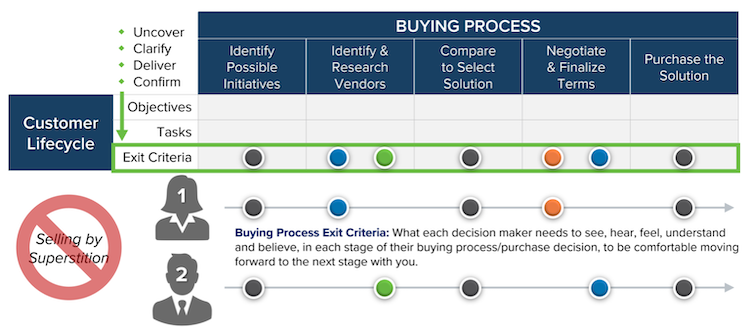
Each process stage has objectives to be accomplished, tasks to be performed, and exit criteria that must be met before moving forward. “Buying Process Exit Criteria” are whatever each decision maker needs to see, hear, feel, understand and believe, in each stage of their buying process, to be comfortable moving forward with you. Some buyers may have the same criteria in one stage, but very different criteria in another.
For this important work, I recommend hiring experts who interview real buyers.
Step 3: Align Your Sales Process with Your Customer Lifecycle
The sales process is the stages that a sale progresses through. The customer lifecycle covers pre-buying, the buying process, and post-buying. Your sales processes should align with your customer lifecycle, including the buying process. The buying process from Step 2 plugs into the customer lifecycle map, and you align your sales motions to it.

Your sales process also has stages, objectives, tasks and exit criteria. There are seller-specific things in your process, such as qualifying an opportunity, but even in your sales process, your exit criteria include ensuring that each decision maker’s buying process exit criteria are met.
Step 4: Adopt an Effective Sales Methodology
Sales methodology is how your sales reps sell. It includes all the buyer or client-facing selling tasks, and the frameworks, models and skills needed to succeed (sales competencies).

If you are doing B2B complex, consultative selling or selling high-value solutions to solve complicated problems, I recommend a full-cycle, buyer-centric, consultative, value-based and outcome-oriented sales methodology. You should align your methodology to the customer lifecycle, including the buying process. Many methodologies only cover a portion of customer interactions.
Step 5: Develop Buyer-Centric Messaging
Building on the Buyer Acumen step, your marketing team (content and product marketing, in conjunction with sales enablement) can build buyer-centric scripts, messaging, marketing collateral, buyer engagement content and playbooks incorporating what they learned from their persona research. This chart offers suggestions of how to start that process together.
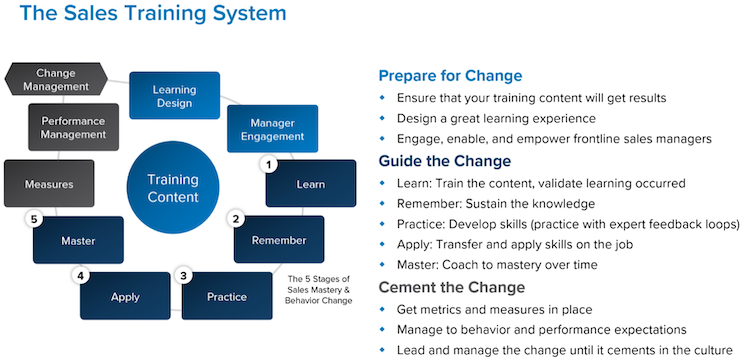
COIN-OP surfaces here again and runs like a needle and thread through the steps you can take to build buyer-centric messaging and prepare for better business conversations by product. Learn more about POSE and the value drivers to communicate with your buyers.
Step 6: Build an Effective Content Plan
Your buyer research can also fuel content marketing and buyer engagement content plans to support sellers in generating interest and opportunities and meeting exit criteria (to win those opportunities).
If you know the exit criteria for each persona in each buying process stage, you can create content to satisfy their criteria. If you typically work with four personas in your opportunities, you might need four or more pieces of content per stage. The important thing is that you have a strategy behind the content plan, based on your buyer acumen work.
Step 7: Use a Sales Training System
You’ll want to use the sales training system for front-line sales manager training and preparation, and for training your sales reps on the key behaviors that will determine success (such as the above-defined processes and methodology).
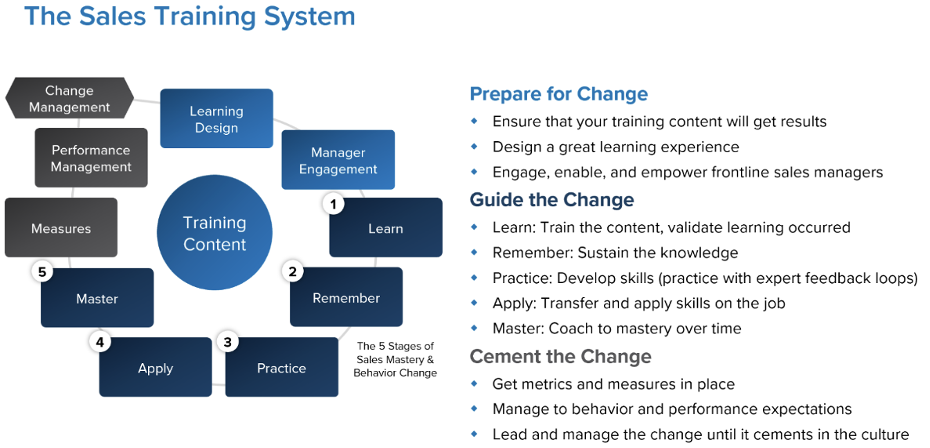
Training managers first is the right, long-view approach, to make a full transformation possible. Front-line sales managers are a force multiplier.
After managers are trained in what their reps will learn, and trained in how to support their reps, you can train sales reps. Have a plan to guide them through the five stages of sales mastery and behavior change: Learn, Remember, Practice, Apply, Master. Stick with your reinforcement plan long enough to ensure the changes become “how we do things around here” and are embedded in your culture.
Step 8: Develop Sales Coaching Excellence
There are few performance enhancers that are more powerful than sales coaching. This is how you will sustain the transformation through ongoing development and coaching to reach mastery, over time. Put a self-sustaining system in place, with a coaching framework, diagnostics, processes, field training and sales coaching models, personalized learning plans, action plans, and a cadence of continuous improvement.
Step 9: Implement a Sales Management System
In most sales organizations, we over-burden the frontline sales managers and prevent them from spending enough time with their sales reps.
The first step of the sales management system is to remove barriers to frontline manager engagement. You must also support managers in not only guiding the changes you want to see in your sales force, but cementing the new, aligned way of selling into your culture, long-term.
Next, you should determine both the activities and meetings that you want your sales managers conducting and document and train what’s included in each, the best practices and the cadence for each. Then, run your business with this sales management operating system.
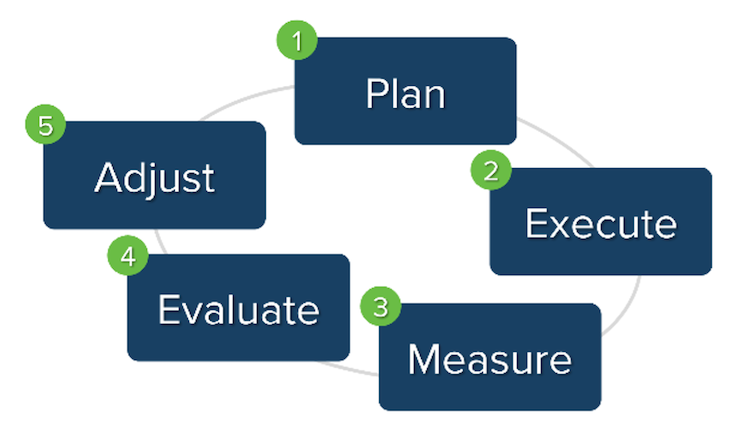
Step 10: Use the Plan, Execute, Measure, Evaluate, and Adjust Loop
This step looks short and sweet, but there’s some real power in it.
After planning, you execute, measure, evaluate and adjust, and continue through the loop until you get the results you want. It sounds simple, but many companies don’t stick with their transformation initiative long enough to foster change and see results.
And those are the 10 steps to future-proof your sales force and radically transform results!
Learn More In a Free Webinar
For more detail on this extensive approach to transformation, join Mike on Wednesday, September 15 at 2 p.m. Eastern for his free webinar 10 Steps to Radically Transform Sales Results & Future-Proof Your Sales Force.
Get our newsletter and digital focus reports

Stay current on learning and development trends, best practices, research, new products and technologies, case studies and much more.



